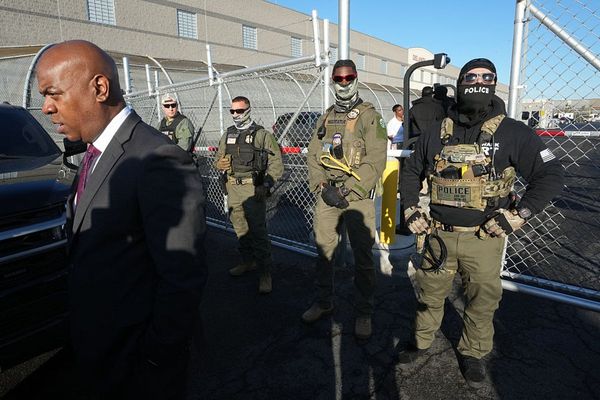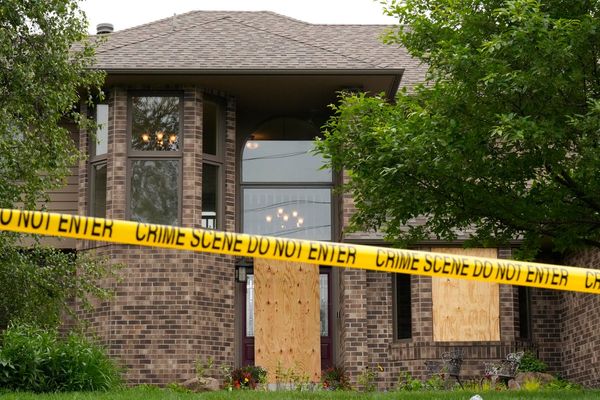
An additional 20 million people in England are to be moved into the toughest local coronavirus restrictions amid warnings of "sharply rising cases" and with hospitals close to being overwhelmed.
On December 30, the UK recorded 50,023 new Covid-19 infections, and a further 981 people have died within 28 days of testing positive for the virus.
At the formal review of the tiered restrictions for England, Matt Hancock, the Health Secretary, escalated measures for millions of people across the country, saying: "Sharply rising cases and the hospitalisations that follow demonstrate the need to act where the virus is spreading."
From New Year's Eve, all of the North-East, Greater Manchester and large swathes of the Midlands and the South-West will be issued a stay at home order, joining London, the South-East and the east of England. It leaves 78 per cent of England now in the toughest Tier 4 restrictions, although the Government stopped short of introduced a fifth, more stringent tier, or a national lockdown.
No part of the country will be in Tier 2 and only the Isles of Scilly – with 2,224 inhabitants – remains in the lowest tier of restrictions. More than 895,000 people will move from Tier 2 to Tier 4, 19.1 million people will move from Tier 3 to Tier 4 and 6.6 million go from Tier 2 to Tier 3.
Under Tier 4 rules, people are urged to stay at home, non-essential retail, indoor gyms and personal care services must close, travel between areas and abroad is restricted and people can only meet one person in an outdoor space.
According to the latest data, between December 18 and 24 the weekly case rate in England rose to 402.6 per 100,000, a 32 per cent increase on the previous week. The NHS reported that 14,915 patients have been admitted to hospital with Covid-19 in the past week, an 18 per cent increase on the week before.
In the North-West, rates have increased by 31 per cent to 223.9 per 100,000. In the South-West, there has been a 37 per cent increase in cases to 175.1 cases per 100,000 with a sharp upwards trajectory.
On December 19, Boris Johnson unveiled a new Tier 4 for the capital and areas including Essex, Kent and Surrey in the wake of surging case rates – amounting to a combined population of more than 16 million – were put in this level.
By Boxing Day, the remaining areas of Essex and Surrey were made subject to Tier 4 restrictions, along with Oxfordshire, Norfolk, Suffolk, Sussex and most of Hampshire, leaving more than 24 million in people in England subject to Tier 4 restrictions between Christmas and the New Year.
You can enter your postcode below to see which tier your area will now be under at the turn of the New Year.
The areas moved into Tier 4
- Leicester City
- Leicestershire (Oadby and Wigston, Harborough, Hinckley and Bosworth, Blaby, Charnwood, North West Leicestershire, Melton)
- Lincolnshire (City of Lincoln, Boston, South Kesteven, West Lindsey, North Kesteven, South Holland, East Lindsey)
- Northamptonshire (Corby, Daventry, East Northamptonshire, Kettering, Northampton, South Northamptonshire, Wellingborough)
- Derby and Derbyshire (Derby, Amber Valley, South Derbyshire, Bolsover, North East Derbyshire, Chesterfield, Erewash, Derbyshire Dales, High Peak)
- Nottingham and Nottinghamshire (Gedling, Ashfield, Mansfield, Rushcliffe, Bassetlaw, Newark and Sherwood, Nottinghamshire, Broxtowe)
- Birmingham and Black Country (Dudley, Birmingham, Sandwell, Walsall, Wolverhampton)
- Coventry Solihull Warwickshire (Rugby, Nuneaton and Bedworth, Warwick, North Warwickshire, Stratford-upon-Avon)
- Staffordshire and Stoke-on-Trent (East Staffordshire, Stafford, South Staffordshire, Cannock Chase, Lichfield, Staffordshire Moorlands, Newcastle under Lyme, Tamworth, Stoke-on-Trent)
- Lancashire (Burnley, Pendle, Blackburn with Darwen, Ribble Valley, Blackpool, Preston, Hyndburn, Chorley, Fylde, Lancaster, Rossendale, South Ribble, West Lancashire, Wyre)
- Cheshire and Warrington (Cheshire East, Cheshire West and Chester, Warrington) Cumbria (Eden, Carlisle, South Lakeland, Barrow-in-Furness, Copeland, Allerdale)
- Greater Manchester (Bolton, Bury, Manchester, Oldham, Rochdale, Salford, Stockport, Tameside, Trafford, Wigan)
- Tees Valley (Darlington, Hartlepool, Middlesbrough, Redcar and Cleveland, Stockton-on-Tees )
- North East (County Durham, Gateshead, Newcastle-upon-Tyne, North Tyneside, Northumberland, South Tyneside, Sunderland)
- Gloucestershire (Gloucester, Forest of Dean, Cotswolds, Tewkesbury, Stroud, Cheltenham)
- Somerset Council (Mendip, Sedgemoor, Somerset West and Taunton, South Somerset)
- Swindon
- Bournemouth, Christchurch and Poole
- Isle of Wight
- New Forest
The areas moved into Tier 3
- Rutland Shropshire and Telford & Wrekin
- Worcestershire (Bromsgrove, Malvern Hills, Redditch, Worcester, Wychavon, Wyre Forest)
- Herefordshire
- Liverpool City Region (Halton, Knowsley, Liverpool, Sefton, Wirral, St Helens)
- York & North Yorkshire (Scarborough, Hambleton, Richmondshire, Selby, Craven, Ryedale, Harrogate, City of York)
- Bath and North East Somerset
- Devon, Plymouth, Torbay (East Devon, Exeter, Mid Devon, North Devon, South Hams, Teignbridge, Torridge, West Devon, Plymouth, Torbay)
- Cornwall
- Dorset
- Wiltshire
Which areas are hardest hit?
The Government has said it uses five key metrics to assess which areas are worst affected by the virus and whether they need to change the measures imposed locally.
They include the overall case rate, the case rate among the over-60s, the rate of change of new cases, the positivity rate of tests conducted and pressure on local hospitals.
Based on a weighted score assessing a combination of all five metrics, a number of areas were outliers among their tiers before the New Year review.
Positivity rates – the percentage of tests coming back positive – have now almost hit one in five in some areas of England. The rate is 19.7 per cent in Dartford, and 18.8 in Barking and Dagenham.
In areas outside Tier 4 ahead of the New Year review, the positivity rate was highest in Boston (14.7 per cent), Burnley (13 per cent), and South Tyneside, Lincoln and Pendle (12.7 per cent). The average rate across Tier 4 is 9.9 per cent.
Hospital occupancy rates are highest in areas due to move from Tier 3 to Tier 4. They include Barrow-in-Furness, Hartlepool, Stockton-on-Tees, Sunderland and South Lakeland, where the occupancy rates are above 30 per 100,000.
The rate of new admissions is also very high in some current Tier 3 areas, including Hyndburn, Blackburn, Burnley and Barnsley (above three per 100,000).
Taking a measure of all the metrics the Government uses, the Tier 3 areas worst hit by Covid include Burnley, Hartlepool, Blackburn, Lincoln and Pendle, although all of the these regions have since been moved into Tier 4.
Burnley has a case rate of 499.3 and a positive test rate of 13 per cent, with high hospital admission and occupancy rates.
Eden and Carlisle were the hardest hit areas in Tier 2. In Eden the case rate is 495.7 and in Carlisle 331.3. Both areas have seen rates double in the last week of data.
What are the new rules and how long will they last?
The tiers system will remain in place until March at the earliest, although the placement of an area in each tier will be reviewed every two weeks.
However, areas can move up tiers outside the fortnightly review if urgent action is needed, as happened with London on December 19.
Following the introduction of Tier 4 restrictions, Mr Hancock has said the new rules could be in place until the vaccine has been rolled out, warning that the next couple of months will be an "enormous challenge".
How are tiers decided?
Decisions on tiers are made by ministers based on public health recommendations informed by the following factors:
-
Case detection rate (in all age groups and, in particular, among the over-60s)
- How quickly case rates are rising or falling
- Positivity in the general population
- Pressure on the NHS – including current and projected (three to four weeks out) NHS capacity – including admissions, general/acute/ICU bed occupancy, staff absences
- Local context and exceptional circumstances such as a local but contained outbreak.
If these indicators are not improving, an area may be moved up a tier and, if the trajectory improves, the area may move to a lower tier.
Will anything change now we have a vaccine?
In the wake of the news surrounding the approval of the Pfizer/BioNTech vaccine, Mr Johnson addressed the previous three-tier system, acknowledging that the restrictions were "tough" but essential to "keep the virus under control".
In a press conference on December 2, he said he hoped areas could "come down the tiers" before the Easter holiday, but emphasised it was necessary that the restrictions stay in place alongside the vaccine and added: "For the time being, you've got to take it that tiering will be a very, very important part of our campaign against coronavirus."
Mr Johnson also said the UK still had "some months before all the most vulnerable are protected” and must remain cautions and not be "carried away with over-optimism". He emphasised that the Government’s plan relies on the public's continued sacrifice “for those we love”.
During a press conference from Downing Street on December 16, Professor Chris Whitty, the chief medical adviser, said social distancing would remain in place after the vulnerable received their vaccinations, as members of the public beyond this group would be at risk.
He said: "Population immunity will occur if we have vaccines that can reduce transmissions between people", adding that he had a "high degree of confidence" that the jab would lower the risk of Covid by a "large amount".
It is not certain whether the Pfizer/BioNTech vaccine will protect people against the new strain of coronavirus, although experts believe it will still be effective, and further studies will take place in order to gain a definitive result.
Ugur Sahin, the chief executive of BioNTech, said on December 22 that "we don't know at the moment if our vaccine is also able to provide protection against this new variant" but, because the proteins on the variant are 99 per cent the same as the prevailing strains, BioNTech has "scientific confidence" in the vaccine.
However, the most recent figures follow concerns from scientific advisers who have warned that one million Covid vaccinations a week will not be enough to bring the pandemic under control.
The director of the Wellcome Trust, Sir Jeremy Farrar, who advises Sage, said: "We're not going to be free of this pandemic by February; this is now a human endemic infection. If we do manage to hit the target of a million [vaccinated] a week, frankly I don't think that's enough to speed that up if we wanted to get the country covered."
But the Oxford vaccine was approved by the MHRA on December 30, and the vaccine rollout is expected to begin on January 4.
The Government is aiming for two million people to receive their first dose of either the Oxford vaccine or the Pfizer jab within a fortnight as part of a major ramping up of the inoculation programme. The Telegraph can also disclose that mass vaccination centres at sports stadia and conference venues are primed to launch in the second week of January.
An army of more than 10,000 medics and volunteers has been recruited by the NHS to help deliver the Oxford vaccine.
Professor Andrew Pollard, director of the Oxford Vaccine Group and chief investigator of the Oxford trial, said: "The regulator's assessment that this is a safe and effective vaccine is a landmark moment, and an endorsement of the huge effort from a devoted international team of researchers and our dedicated trial participants.
"Though this is just the beginning, we will start to get ahead of the pandemic, protect health and economies when the vulnerable are vaccinated everywhere, as many as possible as soon possible."
Although having two effective vaccines that have been approved is good news, it is highly likely that the tier system will remain in place during the mass vaccination roll-out.
What about the rest of the UK?
Mainland Scotland entered Tier 4 on Boxing Day after Nicola Sturgeon announced the harshest level of restrictions would last for three weeks. Travel between Scotland and other UK areas is now banned, and Scottish schools will close for an additional fortnight until January 18, with online lessons beginning on January 11.
The whole of Wales moved into a full national lockdown on December 20. The news came as Covid patients in Welsh hospitals surpassed 1,900 for the first time during the pandemic. Secondary schools have also been closed.
Northern Ireland re-introduced a complete lockdown on Boxing Day. The restrictions are expected to last for six weeks and include the closure of non-essential retail and hospitality venues without takeaway services.
Got a question about the new tiers system? Comment below or email yourstory@telegraph.co.uk for your questions to be answered by our experts.







